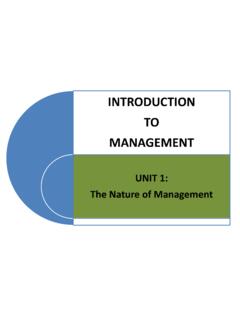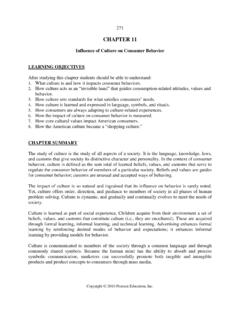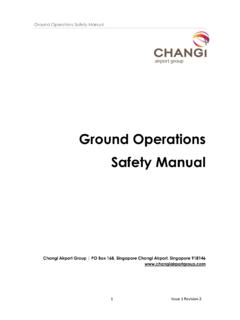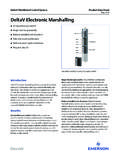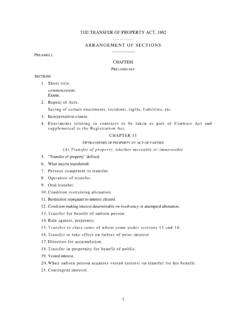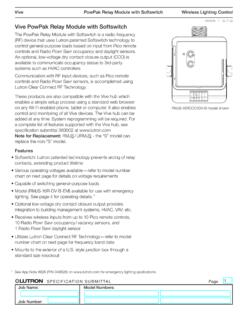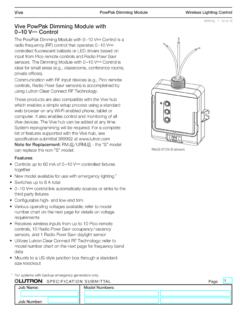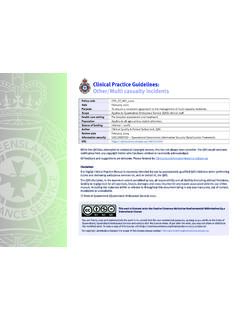Transcription of Unit 4: Warehousing Procedures - NUST
1 Unit 4: Warehousing ProceduresBy: Ester KalipiDate: 16 April 2018 Table of contents of the of efficient Warehouse and Radio Frequency Identification (RFID)1. Objectives of the LessonBy the end of this unit, students should be able to: Define a warehouse; Describe the warehouse process required for smooth operation; Explain the functions of the warehouses; Differentiate the different types of A warehouse is a commercial building for storage of goods. Warehouses are used by manufacturers,exporters, wholesalers, retailers,transport businesses, customs (exporters, Importers), etc. Theyareusuallylargeplainbuildings,equipp edwithloadingdockstoloadandunloadconsign mentfromtrucks. Baseduponthesizeofthegoodsandvolumeofope rationtheyalsooftenhavecranesandforklift sformovinggoods,whichareusuallyplacedonI SOstandardpallets. Insimplewords,warehouseisafacilitywheret hesupplychainholdsorstoresgoods, ,wholesalers,retailerstostorethegoods.
2 ,inmanylogisticalsystemdesigns,theroleof thewarehouseismoreproperlyviewedasaswitc hingfacilityascontrastedtoastoragefacili ty. The function of a warehouse is conceptually very simple: to receive goods into the facility, to store these goods and, when required to dispatch the to Logistics & Marketing ~ SFT 1002A Warehouse is: A place where storage and materials handlingactivities are performed The precise nature will vary depending on company, product and market circumstances Warehousing is closely related to inventory managementFunctions of the Warehouses Receivinggoods receiveandacceptresponsibilitybyupdating records Identifyinggoods placelabel,colourcode(Normalstocks,Promo tionalstocks,Specialcustomerstocks,Price changedbatchetc). ,revisedpricegoods,Promotionalgoodsshoul dbesortedoutseparately. Dispatchingputawaythesortedgoodstoapprop riatestorageplace-fortemporarystoragewit heasyaccessibility Holdinggoods-securityagainstpilferageand deterioration Selecting,retrieving,packing-itemsareret rievedandgroupedaccordingtocustomerorder fordispatch Marshallinggoods-checktheitemsofasingleo rderforcompletenessandorderrecordsareupd ated.
3 Dispatchinggoods-consolidatedorderispack agedanddirectedtorighttransport Preparingrecordsandadvices-ofstocksandre plenishmentrequirementsIntroduction to Logistics & Marketing ~ SFT 1002A Warehouse is:A planned space for the efficient & effective accommodation of goods and materialsTherefore it has two key features: Storage HandlingKey Point:There is an important Trade-Off between these two functions!Efficiency v s Effectiveness?Introduction to Logistics & Marketing ~ SFT 1002 The Objectives of a Warehouse :To attain the best combination of: the maximum of storage space in cubic terms Efficiency ? the minimum of handling operations Effectiveness ?Introduction to Logistics & Marketing ~ SFT 1002 Goods In Receiving Inspection Put away Storage Housekeeping Picking Replenishment Despatch Order assembly Packing Checking MarshallingMain Jobs in a Warehouse :Warehouse process Thislooksattheprocessesthatsupporttheact ivitiesofreceiving,storinganddispatching .
4 Eachofthesemustbeprovidedforandperformed precisely. Alltheprocesseshaveadirectorindirectinfl uenceonthestock. Thefunctionofwarehouseisgettingfocusedfr omstorage-dominancetotransactiondominanc e. The Warehousing functionality today is much more than the traditional function of ProcessesGoods Outward / DespatchOrder Selection / PickingPut AwayGoods In / ReceivingWarehouse process and operations. The design, good and time pressures vary from facility to facility. The following process are inherent in all facility: Stock purchasing In-bond transport arrival and identification of loads Receiving Bay Transfer of stock into storage Pick face replenishment and let down of stock Dispatch assembly area or assembly of the goods to create a transport load Delivery of goods and obtaining proof of delivery (POD) POD and billing Return of unwanted goods Stock write-off Stock count Pick face replenishment and let-downGoods in upper racks are moved to the pick area so that there is always sufficient stock for picking or to the dispatch area if full pallets are picked.
5 Stock pickingA pick note for the store is produced by the WMS. Full pallets are picked via the let-down process and partial pallets are picked from this pick face. Order processingThe order is received from the client. The stock is checked for availability of all items. The client is advised of the stock that is available to be ordered. The client s order is matched with available stock. The stock is reverse through the WMS. Stock not available is expedited from suppliers. The client either reorders the unavailable stock or the warehouse sends the stock immediately once it is received (back-order)Transfer into storageGoods are recorded in the WMS. The WMS issues the position where goods are to be stored. The goods are moved to storage. The completed move is recorded in the WMSS tock Management Stock purchasing Stock is ordered to match the desired inventory levels. Stock order sizes and frequency are chosen to ensure that deliveries occur in time.
6 Inbound transport arrivalTransport checking process: supplier transport arrives at the warehouse, verified if its at the right facility and checked to see if goods are scheduled for delivery. Receiving BayThe transport is assigned a door to unload. Goods are unloaded into the receiving bay. Goods are identified & checked for quantity & quality. Good are stored if in good condition & written-off in poor condition. Write-off stockStock to be written-off is recorded in the WMS as delivered to stock write-off at reduced or zero value. Stock is disposed of outside of the warehouse. POD and BillingThe POD is received from the transporter. The client is billed. Returns are recorded correctly and the client is credited with the CountStock is verified by cycle counts and stock targetsDispatch assembly areaPicked goods are moved to dispatch assembly area. Goods are checked to match the client s order.
7 The shipping documents and invoice are produced. Delivery Goods are loaded onto the transport from the dispatch area. Transport is released to leave. Deliveries are done and the POD received from clients. Rejections are retained by the transporter to return to the warehouse. Return of unwanted goods Returns must be authorized by the warehouse. Transporters return goods to the warehouse. The transport is identified as returning loads. Source: Pienaar & Vogt (2009)Stock purchasing The facility must carry the correct stock to provide cost-effective and cost efficiency means to customers. This process is achieved through the replenishment of the inventory The aim is to alter the buying quantity or frequency so that there is a continuous flow of products is moved in the facility to match the uncertainty in inbound supply channel, while matching orders received from customers. Placing an order lead to the arrival of inbound transport to the facility, hence if the process is managed and coordinated well the transport will be arrival and identification of loads Transport must be scheduled Arrival of transport must be planned so that the facility can provide staff to handle the unloading, the equipment to move the goods and capacity to handle any discrepancies between the stock ordered and delivered.
8 The recommended steps to handle transport The supplier books the transport load to be delivered to the facility The load details are confirmed with the facility Transport arrives at the facility within the scheduled arrival period and the check is merely a confirmation of the load. The order number is checked. The door where the truck should be discharged can now be allocated. The truck waits for the door to become available; it is then discharged quickly and Bay Once the receipt of transport is arranged, orders can be unloaded. The facility must transfer the goods into storage The facility will incur the financial responsibility of for the purchased goods The receiving bay process involves checking the quantity and quality of the goods. The packaging must be in good condition and suitable for storage and sale. The unloading must be efficient and cost effective for all parties, yet allowing checking of quality and quantity.
9 The best method: Allocate the receiving Bay for the goods. Choose a door that minimizes the distance the product has to travel to its storage location Load the goods from the truck and place them on the floor, starting as far from the ruck as possible in the first of demarcated (marked) of stock into Storage Goods must be moved into a designated storage space The move must be confirmed with the warehouse management system (WMS), if not done the WMS will assume that the goods are still in transit between the receiving bay and stock location, there Clear marking of the storage location lead to accuracy. Error of the product in the wrong location is a major problem because it means that the product is not available. The code number is allocated for each slot, which is used to confirm that the process has been completed correctly. Racks are often identified by designating three alphabetical characters to each space.
10 A05E may refer to a location in the row of racks marked A the 05 column of spaces in the row (two characters are used in this group as the number of columns may exceed ten) and space marked E , which is the fifth space vertically in this and let-down of stock to pick face Full pallets are stored in the upper levels so that the easily accessible levels are left for pick faces. The process of moving pallets from these upper storage levels either to pick face or the dispatch area is called Let-down. Pick face replenishment place where the selection, or pick of a product for dispatch occurs. It is usually near the floor or walkway level, where the goods can be accessed easily. As stock is picked from the a pick face it needs to be replenished. Pick-face replenishment must be done as highest priority activity in the pick cycle because it is not done it time it may result into stock shortage at the pick face, delaying the pick process Let-down for full pallet stock pick when an order of more goods is received than held on one pallet, it is better to allocate a full pallet first to replenish an order and remaining part of the order is then picked from the pick-face.



